The crisp, chilly air and winter wonderland scenery bring so much glittering white to the coldest season of the year. Winter is a fresh and stark change after the many colors that erupt in the autumn landscape.
Winter signals its entry when the trees begin dropping their leaves, going into dormancy.
Sure, this season makes you want to snuggle indoors with a cozy blanket next to your fireplace, but just as you prepare for the season by trading your shorts and t-shirts for long pants, coats, hats and gloves, you should prepare your landscape to weather the winter.
For help on how to do this right, follow our ultimate checklist of winter tree care tips.
CLICK HERE TO DOWNLOAD A COPY OF THE WINTER SEASONAL TREE CARE CHECKLIST.
Tree Trimming and Pruning
Winter tree trimming is an annual maintenance task that is important for the overall health of your trees and shrubs.
Prune for Shape, Structure, and Health
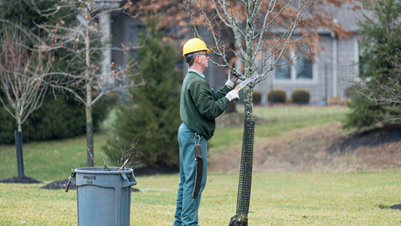
Since the growth of your trees slows down and the leaves of your deciduous trees are no longer in the way during winter, branch visibility improves.
This means arborists can more easily improve branch patterns to direct future growth. This amplifies pruning precision for optimum shape and structure.
Dormant tree pruning is a great way to get rid of branches you don’t need: those that are dead, diseased, or broken.
This boosts your tree’s overall strength so when heavy snow and ice collect, there’s less of a chance for branches to fall. This helps prevent accidental branch breakage and enhances the safety and security of the trees in your yard.
Prune Oaks and Elms Per Arborist Instructions
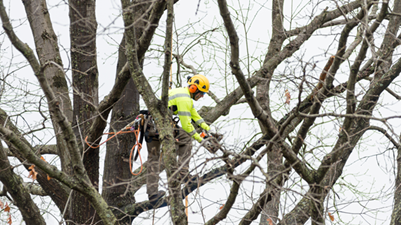
Want to limit the spread of certain diseases like oak wilt or Dutch elm disease? Try dormant tree trimming.
Not only can arborists spot some diseases easier when working on a bare tree, but winter cuts make trees like oaks and elms less likely to attract disease-carrying insects.
Remember, if you’re concerned about your oaks and elms and the threat of disease when pruning, a certified arborist can tackle the job and educate you on your tree health in the process.
Inspect Trees and Shrubs For …
The next important winter tree care step is inspection. You want to keep an eye out for specific problems that can result during these colder months.
Snow and Ice Damage
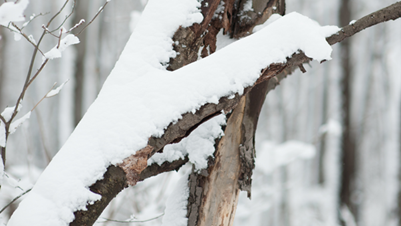
When snow falls, each individual flake looks light and airy. But when these flakes pile up, it gets heavy.
Check your trees for any damage after those severe snow storms. You’re looking top to bottom for broken twigs and branches, holes in the trunk, cracks, and decay.
Tree Insects and Diseases
You also want to check your trees for any insect or disease concerns. Some insects and diseases can spread quickly, so if you notice any signs of tree deterioration, discoloration, or decay, contact your arborist for a free inspection. A spring treatment could help save your tree if an infestation is present.
Soil Care
The ground may freeze in the winter, but that doesn’t mean you should forget about your soil and the nutrients and rooted “homes” it provides for your beloved trees and shrubs. Soil care is an important part of winter tree care.
Fertilize Trees and Shrubs
Trees can lose nutrients throughout the year. And urban and suburban soils don't help; they aren’t as nutritious or full of organic matter as the forest floor.
A slow-release fertilizer application can replace these nutrients and improve your trees’ resistance to insects, diseases, and nasty winter weather.
Keep Rock Salt Away From Trees
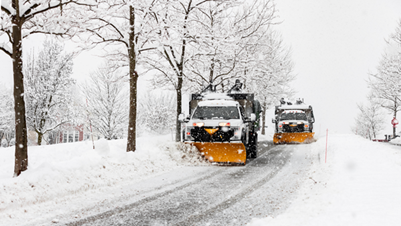
No one wants to slip and fall when ice and slick snow makes our driveways and walkways like skating rinks. So we use rock salt to melt the ice and keep the surface safe.
But, in the process, it's crucial to remember that salt can damage your trees.
Excess salt can penetrate your soil, and this upsets the water balance between soil and roots, causing dehydration. You see this when it causes yellowing or burnt looking needles or leaves.
To keep your trees safe, you can choose a salt with calcium chloride or magnesium calcium acetate, which are less harmful to plants than sodium chloride.
If you suspect salt damage, you can hire an arborist to help you wash the salt out of your trees’ soil when snow clears to rinse away. Salty soil can also be treated with organic matter in spring
Pre-Treat Turf and Beds Near Surfaces Where Salt Will Be Applied To Reduce Salt Damage
Rock salt can leach moisture from your lawn, as well as your other plants.
You can minimize your salt use on walkways or driveways near your lawn or try putting up a snow fence to keep the salt damage low.
If you suspect your lawn has suffered some salt damage, you can use a lawn spreader to apply a thin layer of granulated gypsum to absorb the salt, help aerate your soil for better air and water penetration, and heal your grass.
Protect Trees and Shrubs
Worried about your trees and shrubs as we head into the winter season? As Ben Franklin said, “By failing to prepare, you are preparing to fail.” To help your trees withstand winter’s worst, here are some tips on preparing your trees for winter.
Wrap Tree Trunks to Prevent Cracks and Damage from Vermin
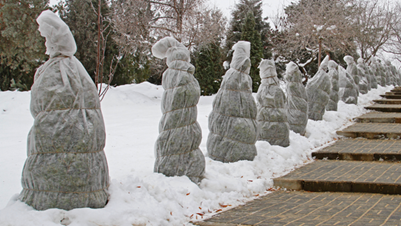
Some of your trees can benefit from a little extra protection before winter strikes.
Young trees, trees with thin bark, and arborvitae can benefit from a burlap tree wrap or plastic tree guard at the base. This wrap discourages damage from herbivores such as deer antler rubbing, or girdling by rabbits or voles. It also discourages feeding by sapsuckers, a type of wood-pecking bird.
This wrap also prevents sunscald, which is when the tree’s bark is harmed when the sun’s warmth is followed by the sudden cold temperatures after sunset. This can also impact evergreen needles as they soak up sunlight and then instantly dry out and brown when that sun disappears and that warmth is quickly gone.
Spray an Anti-Desiccant to Reduce Moisture Loss in Evergreens
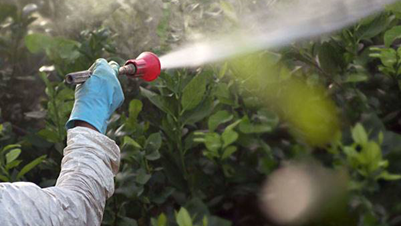
Winter is a dry season. Trees, especially evergreens, can suffer from moisture loss, or desiccation, when the season’s harsh conditions dry things out.
Using an anti-desiccant on trees can help lock in moisture and slow this water loss. Understanding when to apply anti-desiccant is essential. It’s best to use these products when the tree is dormant and dry, and the temperature is above freezing but before the harshest winter conditions arrive.
Gently Remove Snow From Tree Limbs
When you see snow bent trees or branches hanging heavy with snow, your first instinct might be to shake that snow off.
The best thing to do, however, is to let that snow melt and give the branch a chance to recover on its own. This is especially true with ice; never try and remove it on your own or you could make any damage worse.
But if the storm just ended and the snow is fluffy, you can use a soft broom to very gently brush the snow off evergreens by sweeping in an upward direction.
When the snow melts in spring, check your trees for damage to ensure they’re OK.
Apply Dormant Oil to Help Protect Against Overwintering Pests and Spring Infestations
Just like we hibernate indoors during the winter, insects like to find places where they can get shelter and food, and trees can provide great options.
While you might think they won’t cause problems, the moment spring arrives they will get busy feasting on your tree and multiplying.
An arborist can apply dormant oils to your tree in winter to smother overwintering pests and prevent these problems.
Lawn Care Tips for Winter
Winter prep includes giving your lawn some attention in addition to your trees and shrubs.
When Frost is Present, Minimize Foot Traffic
Frost develops on cold, clear nights. Since grass blades move water through them for nourishment, the moisture from frost can freeze inside the blades.
Walking on frosty grass, therefore, can break grass blades. Damage can be seen on blades with a tan hue. Your lawn will eventually recover, but this won’t happen until spring.
To minimize damage, minimize foot traffic on your lawn during winter.
Keep Rock Salt Off Your Lawn
As you spread salt on your driveway and walkways to melt ice, there’s a chance you get it into your lawn’s roots, which can dehydrate your grass, actually putting it in a drought-like state.
To protect your lawn from salt, you can install a snow or silt fence around your lawn near those areas where you use salt most, give your lawn a deep soak in spring to drain the salt, and repair any damage with spring seeding.
Use Driveway Markers For Snow Plowing
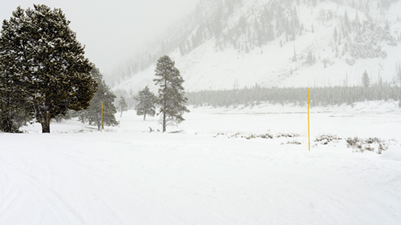
When you use a snow blower or hire a professional to snow plow your driveway, there’s always a chance you get too close to your lawn because the snow height can make you question where your lawn ends and your driveway begins.
To maintain good visibility, use driveway markers to ensure you don’t scrape your lawn with the plow, causing severe turf damage.





